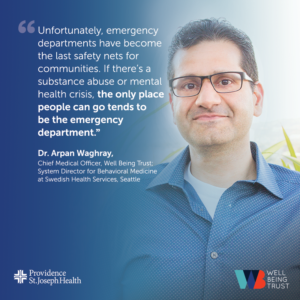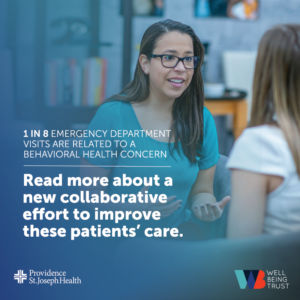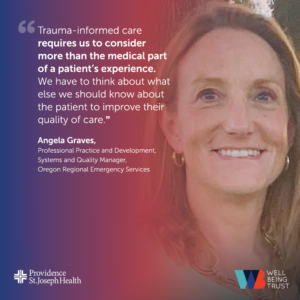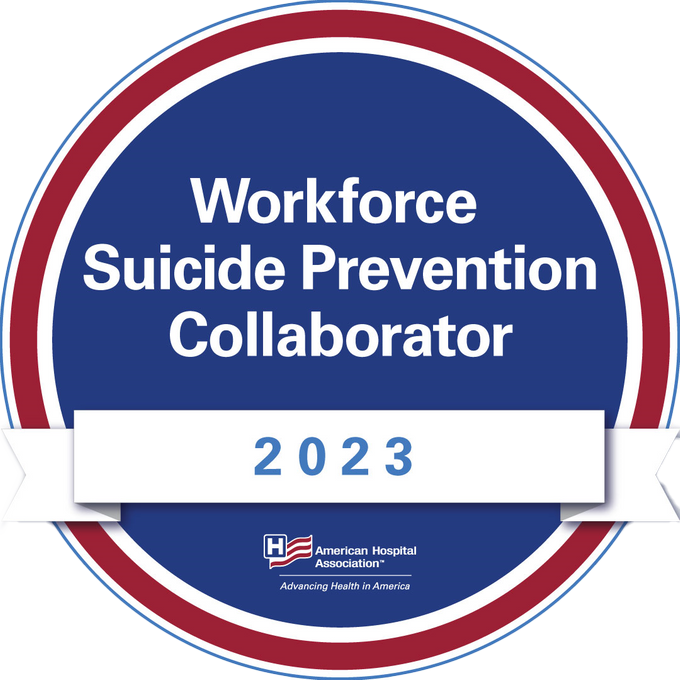Seeking better results for behavioral health patients
Emergency departments aren’t set up for patients with behavioral health concerns. Providence Regional Medical Center Everett is redesigning its standard of care.
Emergency departments are well-designed to understand patients’ medical needs and how urgently they need help. If a patient has chest pain or is turning blue, they’re automatically triaged/prioritized out of the waiting room. But when it comes to treating people with behavioral health issues, standard protocol often fails to adequately provide the most effective care.
“Unfortunately, emergency departments have become the last safety nets for communities,” says Arpan Waghray, M.D., chief medical officer for Well Being Trust and system director for behavioral medicine at Swedish Health Services in Seattle. “If there’s a substance misuse or mental health crisis, the only place people can go tends to be the emergency department.”
The trend has continued to worsen over the years—today, one in eight visits to emergency departments in America is related to a 
In an effort to correct a fragmented system, the Well Being Trust funded the Providence Regional Medical Center in Everett, Washington to work with the nonprofit Institute for Healthcare Improvement. They’re testing new tools and standards to improve the quality of care provided to behavioral health patients in emergency departments across the Providence system.
Systematic approach
As a result, a national learning collaborative with eight leading health systems across the country was launched to consider the patient’s journey from the moment they come to the emergency department to the follow-up care they receive post-discharge.
“If you don’t take a systematic approach to behavioral health patient care, you’ll only see a piece of the puzzle,” Waghray says. “And then you’re just putting a band-aid on the problem, and that’s bound to set patients up for failure.”
To ensure behavioral health patients don’t have expensive and ineffective care experiences, Providence Regional Medical Center is adopting a nursing triage tool developed in Australia that takes behavioral health factors into consideration when processing where patients should be in the line of care.
Consider a patient coming into the emergency department with an asthma attack. Emergency departments will begin treatment, follow up to see if the treatment is effective in stabilizing the patient, and adjust accordingly to ensure they are receiving the proper care. Emergency departments typically don’t use a similar protocol for behavioral health patients.
“There’s a determination that the patient is either going in for inpatient psychiatric care, or they’re going home with generic follow-up 
This new standardized assessment will ensure emergency departments consider behavioral patients’ health status during triage and follow protocols that ensure their care is taken step by step, just as it would be for a medical health complaint. The goal is to equip emergency departments to treat behavioral health patients in a more thoughtful and timely manner to prevent a crisis and improve quality of care.
Trauma-informed
Better triage is only one part of the equation, though, as the medical center considered ways to more effectively treat behavioral health patients, including trauma-informed care, says Medical Director Ryan Keay, M.D.
A trauma-informed approach to health considers the trauma people have experienced in their lives and aims to treat patients with empathy and understanding of those experiences, she says. Currently, staff and providers working in the medical center’s emergency department are undergoing trauma-informed care training. The goal is to incorporate the lessons into new employee training in the future.

“Trauma-informed care requires us to consider more than the medical part of a patient’s experience,” Graves says. “We have to think about what else we should know about the patient to improve their quality of care. A large part of that is about asking the right questions, but it’s just as much about picking up on non-verbal cues, which can be difficult if you don’t know what to look for.”
Beyond the emergency department
Traditionally, behavioral health patients who are discharged from emergency departments don’t leave with a treatment plan, as a medical patient would. Under Providence Regional Medical Center’s new approach to care, patients will leave with an at-home treatment strategy, Dr. Keay said. They are also now receiving follow-up calls from a nurse, who will help them overcome any barriers to accessing care they may have encountered.
Community partners now play a major role in ensuring a smooth transition of care following discharge. Providence Regional Medical Center has reached out to community health partners, law enforcement, emergency responders, and others to share best practices for supporting behavioral health patients. The medical center also works with these partners to develop and follow community-based care plans, in which various partners create a uniform standard of care for behavioral health patients, no matter who is providing it.
These partnerships ensure penetration of methods, such as mental health first aid training and de-escalation methods, are in place within the community. This ensures, people experiencing behavioral health issues have greater support, which could keep them from landing in the emergency department.
To Waghray, these efforts are part of a greater moral obligation to properly care for every patient that walks in the emergency department doors.
“If someone comes in with a stroke, there are specific expectations of care that are consistently followed using the best science we have available,” he says. “I want to bring the same expectations to behavioral health.”






